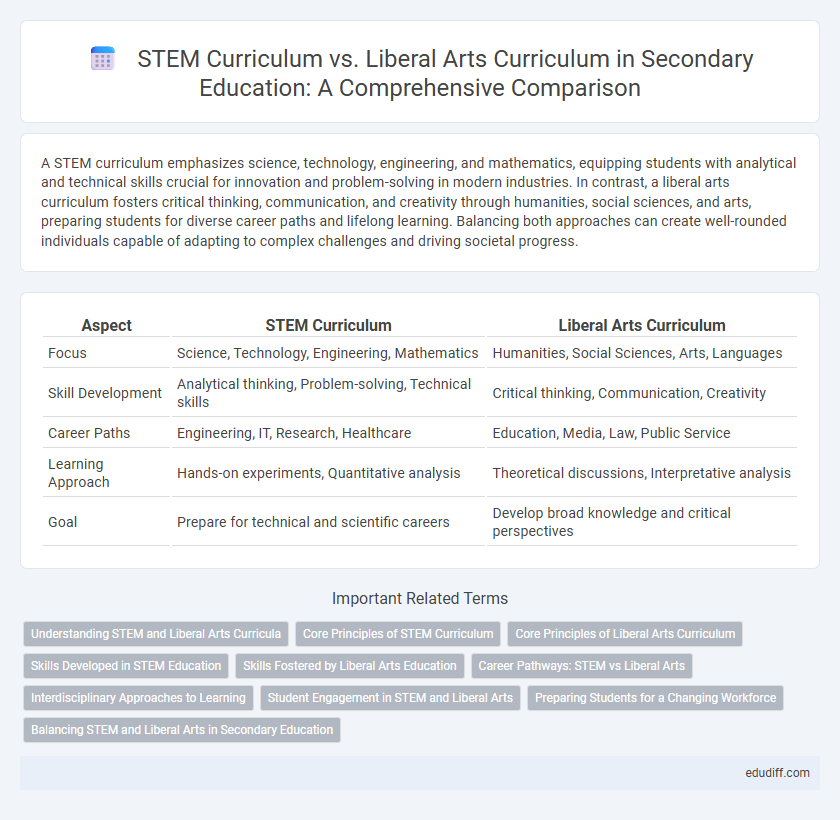A STEM curriculum emphasizes science, technology, engineering, and mathematics, equipping students with analytical and technical skills crucial for innovation and problem-solving in modern industries. In contrast, a liberal arts curriculum fosters critical thinking, communication, and creativity through humanities, social sciences, and arts, preparing students for diverse career paths and lifelong learning. Balancing both approaches can create well-rounded individuals capable of adapting to complex challenges and driving societal progress.
Table of Comparison
| Aspect | STEM Curriculum | Liberal Arts Curriculum |
|---|---|---|
| Focus | Science, Technology, Engineering, Mathematics | Humanities, Social Sciences, Arts, Languages |
| Skill Development | Analytical thinking, Problem-solving, Technical skills | Critical thinking, Communication, Creativity |
| Career Paths | Engineering, IT, Research, Healthcare | Education, Media, Law, Public Service |
| Learning Approach | Hands-on experiments, Quantitative analysis | Theoretical discussions, Interpretative analysis |
| Goal | Prepare for technical and scientific careers | Develop broad knowledge and critical perspectives |
Understanding STEM and Liberal Arts Curricula
STEM curricula emphasize science, technology, engineering, and mathematics, fostering analytical skills, problem-solving, and technical proficiency essential for careers in innovation and technology sectors. Liberal arts curricula prioritize critical thinking, communication, and interdisciplinary knowledge through humanities, social sciences, and arts, cultivating cultural awareness and adaptability. Understanding these distinct curricular goals helps educators and students align academic pathways with career objectives and personal development.
Core Principles of STEM Curriculum
STEM curriculum emphasizes interdisciplinary learning, integrating science, technology, engineering, and mathematics to develop problem-solving skills and critical thinking. Core principles include hands-on experimentation, real-world applications, and fostering innovation through collaboration. This approach prepares students for technical careers by building strong analytical abilities and adaptability.
Core Principles of Liberal Arts Curriculum
The core principles of a liberal arts curriculum emphasize critical thinking, interdisciplinary learning, and effective communication, fostering well-rounded intellectual development. Unlike STEM curricula that prioritize technical skills and quantitative analysis, liberal arts programs cultivate creativity, ethical reasoning, and cultural awareness. This foundational approach prepares students for adaptable problem-solving and informed citizenship across diverse fields.
Skills Developed in STEM Education
STEM education primarily develops critical skills such as analytical thinking, problem-solving, and technical proficiency in fields like mathematics, science, technology, and engineering. It emphasizes hands-on learning, fostering innovation, computational thinking, and data literacy essential for the digital economy. These skills equip students to navigate and contribute to technologically advanced industries, distinguishing STEM curricula from the broader critical thinking and communication strengths cultivated in liberal arts education.
Skills Fostered by Liberal Arts Education
Liberal arts education cultivates critical thinking, effective communication, and ethical reasoning, essential skills that complement the analytical strength of STEM curriculums. Emphasis on interdisciplinary learning and cultural awareness prepares students to navigate complex social contexts and adapt to diverse professional environments. This holistic skill set enhances problem-solving abilities beyond technical expertise, promoting creativity and collaboration across varied fields.
Career Pathways: STEM vs Liberal Arts
STEM curriculum equips students with technical skills and critical thinking essential for careers in engineering, technology, and scientific research, often leading to high-demand, high-paying jobs in rapidly evolving industries. Liberal arts curriculum fosters interdisciplinary knowledge, communication, and problem-solving abilities, preparing students for diverse careers in fields such as education, law, public policy, and the arts. Career pathways in STEM typically emphasize specialization and innovation, while liberal arts pathways prioritize adaptability and broad-based intellectual development.
Interdisciplinary Approaches to Learning
Interdisciplinary approaches to learning integrate concepts from both STEM and liberal arts curricula, fostering critical thinking and problem-solving skills across diverse fields. This educational strategy encourages collaboration between sciences, technology, engineering, mathematics, humanities, and social sciences, creating a more holistic understanding of complex issues. Schools implementing interdisciplinary curricula report enhanced student engagement and better preparation for real-world challenges, reflecting the growing demand for versatile skill sets in the modern workforce.
Student Engagement in STEM and Liberal Arts
Student engagement in STEM curricula typically centers on hands-on experiments, problem-solving tasks, and real-world applications that cultivate critical thinking and technical skills. In contrast, liberal arts curricula emphasize analytical reading, writing, and discussions fostering creativity, ethical reasoning, and communication skills. Both approaches aim to enhance cognitive development and motivation, but STEM often drives engagement through interactive projects while liberal arts rely on reflective, discourse-based participation.
Preparing Students for a Changing Workforce
STEM curriculum equips students with critical skills in science, technology, engineering, and mathematics, essential for adapting to rapid technological advancements and evolving job markets. Liberal arts curriculum fosters critical thinking, creativity, and communication abilities that support problem-solving and adaptability across diverse industries. Combining STEM and liberal arts education enhances students' preparedness for a changing workforce by integrating technical expertise with broad analytical and interpersonal skills.
Balancing STEM and Liberal Arts in Secondary Education
Balancing STEM and liberal arts in secondary education fosters critical thinking, creativity, and problem-solving skills essential for holistic student development. Integrating STEM subjects with humanities enables students to apply scientific knowledge within ethical, cultural, and societal contexts, enhancing their adaptability in a complex world. Schools adopting a hybrid curriculum report improved student engagement and better preparation for diverse career paths in technology, arts, and social sciences.
STEM Curriculum vs Liberal Arts Curriculum Infographic

 edudiff.com
edudiff.com